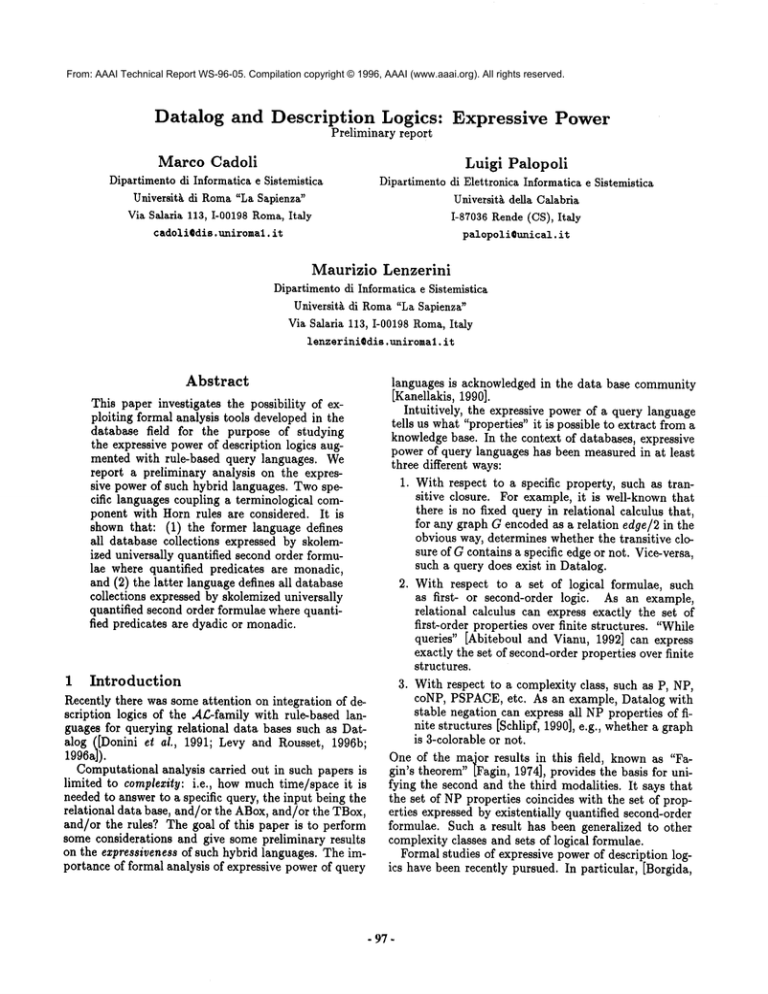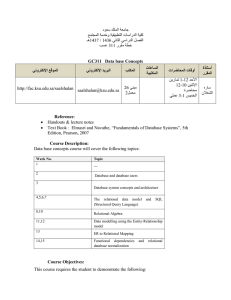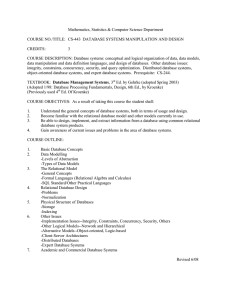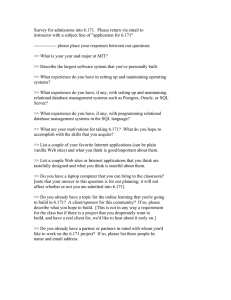
From: AAAI Technical Report WS-96-05. Compilation copyright © 1996, AAAI (www.aaai.org). All rights reserved.
Datalog
and Description
Logics:
Expressive
Power
Preliminary report
Marco Cadoli
Luigi Palopoli
Dipartimentodi Informatica e Sistemistica
Universit~ di Roma"La Sapienza"
Via Salaria 113, 1-00198Roma,Italy
cadoli@dis,
uniromal,
it
Dipartimentodi Elettronica Informatica e Sistemistica
Universit~ della Calabria
1-87036Rende(CS), Italy
palopoli@unical,
it
Maurizio Lenzerini
Dipartimentodi Informatica e Sistemistica
Universit~ di Roma"La Sapienza"
Via Salaria 113, 1-00198Roma,Italy
lenzerlniQdls,
uniromal,
it
Abstract
This paper investigates the possibility of exploiting formal analysis tools developed in the
database field for the purpose of studying
the expressive power of description logics augmented with rule-based query languages. We
report a preliminary analysis on the expressive power of such hybrid languages. Twospecific languages coupling a terminological component with Horn rules are considered. It is
shown that: (1) the former language defines
all database collections expressed by skolemized universally quantified second order formulae where quantified predicates are monadic,
and (2) the latter language defines all database
collections expressed by skolemized universally
quantified second order formulae where quantified predicates are dyadic or monadic.
1
Introduction
Recently there was some attention on integration of description logics of the J4£-family with rule-based languages for querying relational data bases such as Datalog ([Donini et al., 1991; Levy and Rousset, 1996b;
1996aj).
Computational analysis carried out in such papers is
limited to complexity: i.e., how muchtime/space it is
needed to answer to a specific query, the input being the
relational data base, and/or the ABox,and/or the TBox,
and/or the rules? The goal of this paper is to perform
some considerations and give some preliminary results
on the expressiveness of such hybrid languages. The importance of formal analysis of expressive power of query
languages is acknowledged in the data base community
[Kanellakis, 1990].
Intuitively, the expressive power of a query language
tells us what "properties" it is possible to extract from a
knowledgebase. In the context of databases, expressive
power of query languages has been measured in at least
three different ways:
1. With respect to a specific property, such as transitive closure. For example, it is well-known that
there is no fixed query in relational calculus that,
for any graph G encoded as a relation edge~2 in the
obvious way, determines whether the transitive closure of G contains a specific edge or not. Vice-versa,
such a query does exist in Datalog.
2. With respect to a set of logical formulae, such
as first- or second-order logic. As an example,
relational calculus can express exactly the set of
first-order properties over finite structures. "While
queries" [Abiteboul and Vianu, 1992] can express
exactly the set of second-order properties over finite
structures.
3. With respect to a complexity class, such as P, NP,
coNP, PSPACE,etc. As an example, Datalog with
stable negation can express all NPproperties of finite structures [Schlipf, 1990], e.g., whether a graph
is 3-colorable or not.
One of the major results in this field, known as "Fagin’s theorem" [Fagin, 1974], provides the basis for unifying the second and the third modalities. It says that
the set of NPproperties coincides with the set of properties expressed by existentially quantified second-order
formulae. Such a result has been generalized to other
complexity classes and sets of logical formulae.
Formal studies of expressive power of description logics have been recently pursued. In particular, [Borgida,
- 97-
1996] shows some expressiveness results with respect to
the second measure, by showing that description languages built using constructors usually considered in
the description logic literature are characterized by subsets of first-order logic allowing only three variable symbols. [Baader, 1996] gives a methodological contribution,
pointing out that expressiveness must be defined within
a precise formal framework, and proposes the modeltheoretic approach for the characterization of expressive
power. Interestingly,
he shows that the complexity of
inference of two equally expressive languages maybe different.
The major goals of our research are: 1) to investigate the possibility of exploiting the formal analysis tools
developed in the database field within the context of
description logics augmented with rules, and 2) to give
some preliminary results about the expressive power of
such hybrid systems.
The first difficulty that we encounter in such a project
is the different notion of extensional knowledge that
databases and description logics assume. In the first
case, an extensional database denotes a single finite
structure with a fixed domainof interpretation, whereas
this is obviously not true for an ABoxexpressed in a description logic with existential and/or disjunctions. This
aspect disallows direct exploitation of formal tools such
as Fagin’s theorem. Such a problem is also evident if we
translate a relational database D into a first-order formula ¢(D): in fact Reiter [Reiter, 1984] showed that,
order to preserve the intended meaning of D, ¢(D) must
be completed with sentences such as the domain-closure
axiom, the unique-name axiom and the closed-world assumption, which constrain the set of allowed interpretations.
In the present work we assume that the ABoxis empty.
The intensional part is made out of a TBoxand a set of
Horn rules. As usual, we assume that predicates appearing either in the heads of rules or in the relational
part (also called ordinary predicates) do not occur in
the TBox. Therefore, in the following we shall refer to
hybrid knowledge bases A consisting of three components: the TBox, denoted AT, a finite set of Horn rules,
denoted Anand, finally, a finite set of facts (i.e., a relational database), denoted Ae. Ae is the extensional
component of A, whereas An U AT forms the intensional component of A. The intensional component of a
knowledgebase defines a query that is evaluated over its
extensional component.
It is easy to see that Datalog, when augmented with
inclusion axiomstypical of description logics, is able to
capture some coNP-complete queries. As an example, to
check 3-colorability of a graph G = (V, A>encoded as
set of facts Ae = {edge(a, b)l(a , b) E A}, we can write
2-components query:
TBox (AT):
T E redUgreenUblue
red E -~green
green E_ -~blue
blue
Datalog rules
E "~red
(An):
non_3_col ~ edge(X, Y), red(X), red(Y).
non_3_col ~-- edge( X, Y), blue( X), blue(Y).
non_3_col ~ edge( X, Y), green( X), green(Y
The inclusion axioms in the TBoximpose that the three
colors actually partition the active domain, and indeed
AT U An U A~ ~ non_3_col iff G is not 3-colorable
(where ~ denotes the usual logical consequence operator, i.e., validity in all models). In the terminology of
[Levy and Rousset, 1996b], AT is "acyclic", and An
is "non-recursive". Moreover A7 belongs to the class
CARIN-MARC
of "maximal (decidable)
A£CA/7~Recursive CARIN", which includes the constructors U, [7, (_>
n R),3R.C, and negation on primitive concepts. An
is "role-safe", i.e., each of its rules is such that for every
atom of the form R(x, y) in the antecedent, where R is
a role, then either x or y appear in an ordinary atom of
the antecedent. In fact, the TBoxis a set of inclusion
axioms [Buchheit et al., 1993], and concept constructors
used in the TBoxare just boolean. Actually, this is an
A£:-log program[Donini et al., 1991].
The above example just proves that the data complexity (i.e., complexity considering the extensional component as the input and the intensional component(query)
ATU An not part of the input) of,A~-log is coNP-hard,
but it does not imply that either .A£:-log or CARINis
able to express all queries in coNP. Such a distinction
is important since the expressive power of a language
is not necessarily the same as its complexity (it is always less than or equal to 1. Several languages with this
property are known, cf. [Abiteboul and Vianu, 1992;
Eiter et al., 1994]. As an example, a language which
does not capture NP -even if it has an underlying NPcomplete problem- has been shown by Stewart in [Stewart, 1991].
Weremark that imposing an empty ABoxdoes not imply that there is a fixed domainof interpretation. Nevertheless, in the above example, this is harmless, since
non-3-colorability is a property which is preserved for
superstructures (i.e., if a graph G is not 3-colorable then
any supergraph of G is not 3-colorable as well).
Very often, the TBoxes are assumed to contain predicates (concepts, roles) with fixed arity. In the present
paper we restrict our attention to such languages. As
a consequence, we use some results on the expressive
power of fragments of universal second-order logic with
fixed arity [Fagin, 1975]. This is in the spirit of the second modality to measure expressiveness, since those fragments do not naturally correspond to complexity classes,
but form a hierarchy within coNP [Fagin, 1990], which
is orthogonal to the complexity of definable collections:
indeed even the smallest class in the hierarchy (coNP1)
contains coNPcomplete collections.
- 98 -
3-colorable graphs). Nevertheless there are polynomial
collections of databases (e.g., the collection of dyadic relations with even number of tuples) that are not in NP1
In [Levy and Rousset, 1996b] it is proved that the data
[Fagin, 1990]. The class NPi has interesting properties:
complexity (the input being the ABoxand/or the relaas an example, in [Cosmadakis, 1993] it is proven that
tional database) of logical inference in both CARIN-MARCmonadic NP differs from monadic coNP, while this is
and ROLE-SAFE
CARINis coNP-complete, and we showed
a long-standing open question for unbounded NP and
in Section 1 that coNP-complete problems are indeed
coNP.
expressed by very simple CARINknowledge bases, where
In the following, we deal with skolemized second-order
the Horn component is non-recursive. In this section we
formulae of the following kind:
prove two results:
¢ = (3S)(VX)(3Y)(0i(X, Y) V... V 0k(X,
1. That ROLE-SAFE CARIN-MARC =’# with a nonwheregi, ¯ ¯., ek are conjunctions of literals involving rerecursive Horn component expresses all queries
lational symbols in ~ and S, plus relational symbol "=",
that are defined by formulae of the kind
and all relational symbols in S are constrained to be
--3SVX3Y¢(X, Y), where S is a list of monadic
monadic. Each conjunction 0i contains occurrence of
predicates, ¢ is a quantifier-free first-order forsome variables among X, Y. As usual, "=" is always
mula, and X, Y are lists of variables, provided
interpreted as "equality". The set of uninterpreted rethat the input finite structure is given in suitable
lational symbols occurring in formula (1) -i.e., ~ U
form, as specified below. The exponent =,# denotes
will be denoted either by £: or by (ai,...,
al}. In the
availability of pre-interpreted symbols for equality
following art(a) denotes the arity of a predicate
and inequality.
Formulae -,3SVX3Y¢(X, Y) deWeillustrate
a method that transforms a formula ¢
fine queries that form a subset of monadic coNP
of the kind (1) and a finite structure D into a ROLEqueries (hereafter, called coNPi cf. [Fagin, 1975;
SAFE CARIN-MARC
knowledge base A(¢, D) and a query
1990; Cosmadakis, 1993]), which contains several
7. Both A(¢, D) and 7 use an enlarged set of relational
coNP complete queries (e.g., the complement of 3symbols £:’ which is built as follows: (1) each relational
colorability of a graph). At the moment, we do not
symbol a E 13 is in £7; (2) for each relational symbol
know whether this result can be generalized to the
a E L: there is one relational symbol ~ with the same
entire set of monadic coNPqueries.
arity as a in L:’; (3) there is a relational symbol t with
the samearity as X in £:’; (4) there is a 0-ary relational
2. That CARIN-MARC-with a non-recursive Horn comsymbol e in £7. The ROLE-SAFE
CARIN-MARC
knowledge
ponent enriched with boolean inclusion axioms on
base A(¢, D) is built as follows:
primitive roles expresses all queries that are defined
1. for each relational symbol s E S, the following axby formulae of the kind -,3SIVX3Y¢’(X, Y), where
S~ is a list of predicates with arity at most 2 and
ioms are in AT(C):
¢~ is a quantifier-free first order formula, provided
that the input finite structure is given in suitable
2. for each conjunct
form, as specified below. Analogously to the previous case, such formulae define queries that form
^
ei(x,Y) = wl(x,Y)^...
a subset of dyadic coNP (coNP2), and we do not
Y)
^...
Y)
knowwhether this result can be generalized to the
(1 < i < k) in ¢, the rule
entire set of dyadic coNPqueries.
2
The expressive
power
knowledge
bases
of CARIN
The coNP-completeness of querying the CARIN-MARC
and ROLE-SAFECARINknowledge bases established in
[Levy and Rousset, 1996b] serves also as an upper bound
to the expressiveness
when the ABox is empty. In
other words we know that no CARIN-MARC
or ROLE-SAFE
CARINknowledge base can express queries which are not
in coNP.
In the following, ~ denotes a fixed set of relational
symbols not including equality "-" and S denotes a list
of variables ranging over monadicrelational symbols distinct from those in ~. By Fagin’s theorem [Fagin, 1974],
any NP-recognizablecollection D of finite structures over
is defined by a second-order existentially quantified
formula. In particular, NP-recognizable collections D of
finite structures, defined by formulas where all existentially quantified relational symbols are 1-ary, form the
set of NPi collections. As already noted, NP1 indeed
includes NP-completecollections (e.g., the collection of
- 99 -
v.+l(x,Y),..., v.+m(x,
is in AT~(¢), where:
¯ v--/(1 < i < n) is:
- e-C, if wi is = (this is just used here to make
the syntax used for equality uniform to that
used for predicates in $),
- w--7, otherwise;
¯ v,,+~ (1 < i < m) is:
- eq, if w,+i is =,
- w,+i, otherwise.
3. for each relational symbol a Etr, the following
art(a) rules are in An(C);
u(x)
a(X, Y1,..., Yart(a)-
u(x)
a(Yi,...,
Yart(a)-1,
3
4. A~(¢) contains the two rules
t(x) ,-- u(x),
e ,-- eq(X,r), Y)
Furthermore, the query 7 is simply equal to e.
We remark that AT(C)I,.J
An(C) is a ROLE-SAFE
CARIN-MARC
knowledge base.
Now, given a finite structure D, we define the complementary structure D as follows. For each relational
symbol r E D there is a relational symbol ~ in D with
the same arity as r. Then, for each relational symbolF in
and for each tuple t ¯ U~rt(r), D ~ F(t) iff D ~: r(t).
Thus, finally, let AZ(¢, D) = D U D. Weare now ready
for the first main result about expressive powerof ROLESAFE CARIN-MARC.
Theorem2.1 For any skolemized NP1 collection D of
finite structures over ~ -characterized by a formula ¢
of the kind (1)- the ROLE-SAFE
CARIN-MARC
knowledge
base A(¢, D) built according to the above rules is such
that a structure D is in D if and only/fAT-(¢)UAR(f)U
Ae(¢,D) ~
In other words, the theorem says that each collection
of finite structures in skolemized coNP1is definable by
a ROLE-SAFECARIN-MARCknowledge base A(¢, D) and
query 7.
To allow role axioms to occur in AT(C) enhances the
expressive power of the language. Indeed, consider formulae of the form:
0’ = (3s’)(vx)(3Y)(01(x,
Y)v... v 0k(x,
where01,..., 0k are conjunctions of literals involving relational symbols in ~ and S~, plus relational symbol "=’,
and all relational symbols in St are constrained to be either monadic or dyadic. Such formulae define a subset of
NP2 that contains NP-complete problems. We remind
that there are collections of polynomial-time recognizable databases (e.g., the collection of ternary relations
with even numberof tuples) that are not in NP2[Fagin,
1990], and that NP2strictly contains NP1(e.g., the collection of dyadic relations with even numberof tuples is
in NP2).
To illustrate the transformation of a formula ¢ of the
kind (2) into CARIN-MARC= knowledge base At (¢ t, D)
with axiomson roles and a query 7t, we modify the translation provided for the monadic case by adding to the
TBoxA~r, for each dyadic relational symbol s t ¯ St, the
following role axioms:
eq E =
Y E_st "7
Us
st U .~7
= E eq
T x T E eq U "~q
eq U -~’~q
Weare now ready for our second result about expressive
power of CARINlanguages.
Theorem 2.2 For any skolemized NPz collection
D
of finite structures over ¢r -characterized by a formula
= knowledge base
Ct of the kind (P)- the CARIN-MARC
A~(¢t, D) built according to the above rules is such that
a structure D is in D if and only ifA~r(¢’) U A~(¢’)
A~(¢t, D) ~ 7’.
Conclusions
In the present paper we showedthe possibility of exploiting the formal analysis tools developed in the database
field within the context of description logics augmented
with rules. In particular we obtained lower bounds for
the expressive power of two hybrid languages (Theorems 2.1 and 2.2). Upper bound for the expressiveness
of the former language follows from the results of [Levy
and Rousset, 1996b]. Westill have to investigate the
upper bound of expressiveness of the latter language.
In this work we assumed empty ABoxes. Nevertheless the results we presented are valid also if the ABox
contains positive atomic assertions such as red(nodel).
Furthermore, it is important to stress that by allowing
predicates with any arity to appear in the description
logic componentof knowledgebases, we obtain languages
capturing all coNPproperties.
Several questions are still open. Regarding the two
languages we have analyzed in this paper, (1) determine
whether there are queries in coNP2which cannot be expressed by former language, and (2) determine whether
the languages express all (even non-skolemized) queries
in coNP1, resp. coNP2. In general, how to define the
expressive power over finite formulae possibly denoting
infinitely many models?
References
[Abiteboul and Vianu, 1992] S.
Abiteboul
and
V. Vianu. Expressive power of query languages. In
J. D. Ullman, editor, Theoretical Studies in Computer
Science. Academic Press, 1992.
[Baader, 1996] Franz Baader. A formal definition for
the expressive power of terminological knowldegerepresentation languages, aT. of Logic and Computation,
6:33-54, 1996.
[Borgida, 1996] Alexander Borgida. On the relative expressiveness of description logics and predicate logics.
AIJ, 82:353-367, 1996.
[Buchheit et at., 1993] Martin Buchheit, Francesco M.
Donini, and Andrea Schaerf. Decidable reasoning in
terminological knowledgerepresentation systems, aT.
of Artificial Intelligence Research, 1:109-138, 1993.
[Cosmadakis, 1993] S. S. Cosmadakis. Logical reducibility and monadic NP. In Proc. of FOCS-93. 1993.
[Donini et al., 1991] Francesco M. Donini, Maurizio
Lenzerini, Daniele Nardi, and Andrea Schaerf. A
hybrid system integrating datalog and concept languages. In Proc. of AI*IA-91, number 549 in LNAI.
Springer-Verlag, 1991. An extended version appeared
also in the Working Notes of the AAAIFall Symposium "Principles of Hybrid Reasoning".
[Eiter et al., 1994] T. Eiter, G. Gottlob, and H. Mannila. Adding Disjunction to Datalog. In Proc. of
PODS-9J, pages 267-278, 1994.
[Fagin, 1974] R. Fagin. Generalized First-Order Spectra
and Polynomial-Time Recognizable Sets. In R. M.
- 100-
Karp, editor, Complexity of Computation, pages 4374. AMS,1974.
[Fagin, 1975] Ronald Fagin. Monadic generalized spectra. Zeitschr. f. mathem. Logik und Grundlagen d.
Math., 21:89-96, 1975.
[Fagin, 1990] R. Fagin. Finite-model theory-a personal
perspective.
In Proc. of ICDT-90, volume 470 of
LNCS, pages 3-23. Springer-Verlag, 1990.
[Kanellakis, 1990] P. Kanellakis. Elements of relational
database theory. In J. van Leeuwen, editor, Handbook
of Theoretical Computer Science, volume B, chapter 17. Elsevier, 1990.
[Levy and Rousset, 1996a] Alon Y. Levy and MarieChristine Rousset. CARIN:A representation language
combining Horn rules and description logics. In Proc.
of ECAI-96, pages 323-327, 1996.
[Levy and Rousset, 1996b] Alon Y. Levy and MarieChristine Rousset. The limits on combining recursive
Horn rules with description logics. In Proc. of AAAI96, pages 577-584, 1996.
[Reiter, 1984] RaymondReiter. Towards a logical reconstruction of relational database theory. In M. L.
Brodie, J. Mylopoulos, and J. W. Schmidt, editors,
On Conceptual Modelling. Springer-Verlag, 1984.
[Schlipf, 1990] J. S. Sehlipf. The expressive powers of
the logic programming sematics. In Proc. of PODS90, pages 196-204, 1990. Expanded version available
as University of Cincinnati ComputerScience Department Tech. Rep. CIS-TR-90-3.
[Stewart, 1991] I. Stewart. Comparingthe Expressibility of Languages Formed Using NP-Complete Operators. J. of Logic and Computation, 1(3):305-330, 1991.
- 101-




